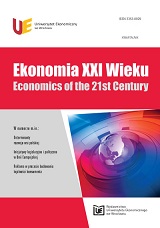Teoria biegunów wzrostu François Perroux i implementacja jej założeń w Hiszpanii w latach 1964-1975
The growth poles theory by François Perroux and the implementation of its assumptions in Spain in the years of 1964-1975
Author(s): Łukasz PiętakSubject(s): Economy
Published by: Wydawnictwo Uniwersytetu Ekonomicznego we Wrocławiu
Keywords: economic growth; growth poles theory; regional policy
Summary/Abstract: This paper is devoted to the analysis of the concept of growth poles theory elaborated by an outstanding French professor François Perroux. In the first part the author presents philosophical and methodological analysis of Perroux’s concepts. The second part is devoted to the analysis of the implementation of the growth poles theory in Spain in the years 1964−1975. The originality of Perroux’s concept lies in the introduction of economic space in a consideration and the omission of the role played by physical space. On the other hand, Perroux’s concept is the generalization of the method applied much earlier by other economists. Perroux’s growth poles theory is the part of theory of harmonized growth, but harmonized growth is not the concept of harmonious growth understood as the natural harmony existing in the economic life. Perroux indicates the need for permanent harmonizing of economic forces for social welfare. Perroux is convinced the economic growth is unsustainable, not only spatially but also by sector. That opinion was not something new. He simply belongs to a group of researchers of economics convinced of unsustainable growth. However, there is one difference. Perroux, not like the others, limits only to establish the fact. He tries to explain why that is. Therefore, he created the theory which explained the phenomenon of unsustainable economic growth. He believes the economic growth appears at the points with different frequencies and at different time. Perroux also points to the industrial complexes and entire industries that can be a source of economic growth which he calls “growth poles”. Growth poles policy was very popular in the 60s and 70s. Many countries like France, Spain, Greece or Italian had poles in their economic plans. This tendency was halted as a result of the oil crisis in 1973. Then the active policy of the state in economic planning began to give the way to economic liberalism. In case of Spain, the growth poles policy consisted in the stimulation of industry formation in regions which give hope for accelerated industrial development. During three consecutive periods of planning in Spain a number of poles situated in different regions were created. At that time in Spain there was a problem of migration towards rich regions like Catalonia, Madrid or Basque Country. Therefore, the aim of the implementation of the poles was not only to develop the industry, but also to stop the migration process. One way to evaluate the functioning of the poles in the Spanish economy is examining the amount of established companies, the level of production and the rate of economic growth obtained in regions with poles, the balance of trade between a region with the pole and surrounding regions. The method used by the author consists in comparing two periods: the first period without the pole and the second period with the pole. The analysis also compares the results obtained with the national average.
Journal: Ekonomia XXI Wieku
- Issue Year: 2014
- Issue No: 01
- Page Range: 185-205
- Page Count: 21
- Language: Polish

